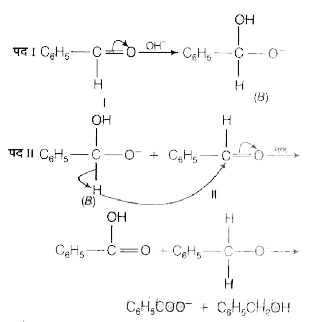कैनिजारो अभिक्रिया में सबसे धीमा प्रक्रम है
2C6H5CHOOH−−−→C6H5CH2OH+C6H5COO−
OH− का कार्बोनिल समूह पर एटैक क्रिया
कार्बोनिल समूह में हाइड्राइड आयन का विस्थापन
कार्बोक्सिलिक अम्ल से प्रोटॉन का हटना
बेन्जिल एल्कोहॉल का डिप्रोटीनीकरण
The correct Answer is:C

B के C-H बन्ध के विखंडन से H− प्राप्त होता है यह II में स्थान्तरित हो जाता है
Topper's Solved these Questions
Similar Questions
e/m के बढ़ते हुए क्रम में (निम्नतम् पहले) इलेक्ट्रॉन (e),प्रोटॉन (p), न्यूट्रॉन (1) तथा α-कण के लिए निम्न सही है
View SolutionAHOH/H+−−−−−−→ ग्लूकोस + फ्रक्टोस
BHOH/H+−−−−−−→ ग्लूकोस + ग्लूकोस
CHOH/H+−−−−−−→ ग्लूकोस + गैलेक्टोस
डाइसैकेराइड A,B तथा C क्रमश: है
View SolutionC6H5CO−COC6H5OH−−−→(C6H5)2OH∣C−COOH
the above reaction is known as
View Solution2C_(6)H_(5)CHO overset(NaOH) to C_(6)H_(5)CH_(2)OH + C_(6)H_(5)COONa The similar reaction can take place with which of the following aldehyde?
View SolutionThe major products that are formed by heating C6H5−CH2−O−C6H5 with HI
(A) 2C6H5I
(B) C6H5CH2IandC6H5OH
(C) 2C6H5OH
(D) C6H5CH2OHandC6H5I
View SolutionWhich of the following reaction are disproportionstion reaction and comproportionaton reactions ?
2C6H5CHO+NaOH→C6H5COONa+C6H5CH2OH
View SolutionIn the reation ,2C6H5∗CHO+NaOH→C6H6∗COONa+C6H5∗CH2OH
View SolutionIdentify A from the following: (i) C_(6)H_(5)COCH_(3) overset(A)to C_(6)H_(5)COOH+CO_(2)+H_(2)O (ii) C_(6)H_(5)COCH_(3) overset(A)to C_(6)H_(5)-underset(OH)underset(|)overset(H)overset(|)C-C_(6)H_(5) (iii) C_(6)H_(5)COCH_(3) overset(A)to C_(6)H_(5)CH_(2)CH_(3)+H_(2)O
View SolutionIn the Cannizzaro reaction given below 2C_(6)H_(5)CHO overset(OH^(-))rarr C_(6)H_(5)CH_(2)OH+C_(6)H_(5)COO^(-) the slowest step is
View SolutionIdentify the electrophile and nucleophile in the following reactions :
(a) C6H5N2Cl+KI→C6H5I+KCL
(b) C6H5N2Cl+C6H5OH→C6H5N=N−C6H4OH
(c) C6H5N2Cl+CH3OH→C6H5OCH3
(d) C6H5N2Cl+H2O→C6H5OH
View SolutionIdentify the electrophile and nucleophile in the following reactions :
(a) C6H5N2Cl+KI→C6H5I+KCL
(b) C6H5N2Cl+C6H5OH→C6H5N=N−C6H4OH
(c) C6H5N2Cl+CH3OH→C6H5OCH3
(d) C6H5N2Cl+H2O→C6H5OH
View SolutionIdentify the electrophile and nucleophile in the following reactions : (a) C_(6)H_(5)N_(2)Cl +KI rarr C_(6)H_(5)I+KCL (b) C_(6)H_(5)N_(2)Cl +C_(6)H_(5)OH rarr C_(6)H_(5)N=N-C_(6)H_(4)OH (c) C_(6)H_(5)N_(2)Cl+CH_(3)OH rarr C_(6)H_(5)OCH_(3) (d) C_(6)H_(5)N_(2)Cl+H_(2)O rarr C_(6)H_(5)OH
View SolutionIdentify the electrophile and nucleophile in the following reactions : (a) C_(6)H_(5)N_(2)Cl +KI rarr C_(6)H_(5)I+KCL (b) C_(6)H_(5)N_(2)Cl +C_(6)H_(5)OH rarr C_(6)H_(5)N=N-C_(6)H_(4)OH (c) C_(6)H_(5)N_(2)Cl+CH_(3)OH rarr C_(6)H_(5)OCH_(3) (d) C_(6)H_(5)N_(2)Cl+H_(2)O rarr C_(6)H_(5)OH
View SolutionCH_(3)OH+ C_(6)OH+ C_(6)H_(5)COOH overset(H^(+)) hArr X+ H_(2)O : What is X?
View SolutionC_(6)H_(5)CHO + HCN rarr C_(6)H_(5)CH(CN)OH . The product would be
View Solution
